
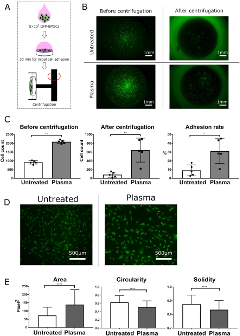
Amine modification of calcium phosphate by low-pressure plasma for bone regeneration
Joe Kodama, Anjar Harumningtyas, Tomoko Ito, Miroslav Michlíček, Satoshi Sugimoto, Hidekazu Kita, Ryota Chijimatsu, Yuichiro Ukon, Junichi Kushioka, Okada Rintaro, Takashi Kamatani, Kunihiko Hashimoto, Daisuke Tateiwa, Hiroyuki Tsukazaki, Shinichi Nakagawa, Shota Takenaka, Takahiro Makino, Yusuke Sakai, David Nečas, Lenka Zajíčková, Satoshi Hamaguchi, Takashi Kaito
Scientific Reports 11 (2021) 17870
DOI: 10.1038/s41598-021-97460-8
Regeneration of large bone defects caused by trauma or tumor resection remains one of the biggest challenges in orthopedic surgery. Because of the limited availability of autograft material, the use of artificial bone is prevalent; however, the primary role of currently available artificial bone is restricted to acting as a bone graft extender owing to the lack of osteogenic ability. To explore whether surface modification might enhance artificial bone functionality, in this study we applied low-pressure plasma technology as next-generation surface treatment and processing strategy to chemically (amine) modify the surface of beta-tricalcium phosphate (β-TCP) artificial bone using a CH4/N2/He gas mixture. Plasma-treated β-TCP exhibited significantly enhanced hydrophilicity, facilitating the deep infiltration of cells into interconnected porous β-TCP. Additionally, cell adhesion and osteogenic differentiation on the plasma-treated artificial bone surfaces were also enhanced. Furthermore, in a rat calvarial defect model, the plasma treatment afforded high bone regeneration capacity. Together, these results suggest that amine modification of artificial bone by plasma technology can provide a high osteogenic ability and represents a promising strategy for resolving current clinical limitations regarding the use of artificial bone.
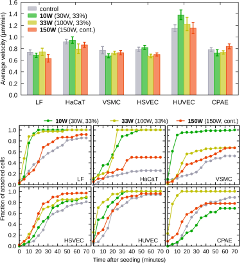
Cell type specific adhesion to surfaces functionalised by amine plasma polymers
Petra Černochová, Lucie Blahová, Jiřina Medalová, David Nečas, Miroslav Michlíček, Preeti Kaushik, Jan Přibyl, Jana Bartošíková, Anton Manakhov, Lucie Bačáková, Lenka Zajíčková
Scientific Reports 10 (2020) 9357
DOI: 10.1038/s41598-020-65889-y
Our previously-obtained impressive results of highly increased C2C12 mouse myoblast adhesion to amine plasma polymers (PPs) motivated current detailed studies of cell resistance to trypsinization, cell proliferation, motility, and the rate of attachment carried out for fibroblasts (LF), keratinocytes (HaCaT), rat vascular smooth muscle cells (VSMC), and endothelial cells (HUVEC, HSVEC, and CPAE) on three different amine PPs. We demonstrated the striking difference in the resistance to trypsin treatment between endothelial and non-endothelial cells. The increased resistance observed for the non-endothelial cell types was accompanied by an increased rate of cellular attachment, even though spontaneous migration was comparable to the control, i.e., to the standard cultivation surface. As demonstrated on LF fibroblasts, the resistance to trypsin was similar in serum-supplemented and serum-free media, i.e., medium without cell adhesion-mediating proteins. The increased cell adhesion was also confirmed for LF cells by an independent technique, single-cell force spectroscopy. This method, as well as the cell attachment rate, proved the difference among the plasma polymers with different amounts of amine groups, but other investigated techniques could not reveal the differences in the cell behaviour on different amine PPs. Based on all the results, the increased resistance to trypsinization of C2C12, LF, HaCaT, and VSMC cells on amine PPs can be explained most probably by a non-specific cell adhesion such as electrostatic interaction between the cells and amine groups on the material surface, rather than by the receptor-mediated adhesion through serum-derived proteins adsorbed on the PPs.
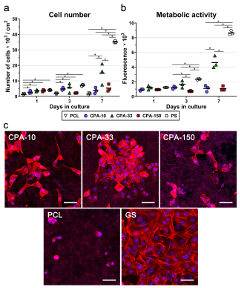
Behaviour of Vascular Smooth Muscle Cells on Amine Plasma-Coated Materials with Various Chemical Structures and Morphologies
Ivana Nemcakova, Lucie Blahová, Petr Rysanek, Andreu Blanquer, Lucie Bačáková, Lenka Zajíčková
International Journal of Molecular Sciences 21 (2020) 9467
DOI: 10.3390/ijms21249467
Amine-coated biodegradable materials based on synthetic polymers have a great potential for tissue remodeling and regeneration because of their excellent processability and bioactivity. In the present study, we have investigated the influence of various chemical compositions of amine plasma polymer (PP) coatings and the influence of the substrate morphology, represented by polystyrene culture dishes and polycaprolactone nanofibers (PCL NFs), on the behavior of vascular smooth muscle cells (VSMCs). Although all amine-PP coatings improved the initial adhesion of VSMCs, 7-day long cultivation revealed a clear preference for the coating containing about 15 at.% of nitrogen (CPA-33). The CPA-33 coating demonstrated the ideal combination of good water stability, a sufficient amine group content, and favorable surface wettability and morphology. The nanostructured morphology of amine-PP-coated PCL NFs successfully slowed the proliferation rate of VSMCs, which is essential in preventing restenosis of vascular replacements in vivo. At the same time, CPA-33-coated PCL NFs supported the continuous proliferation of VSMCs during 7-day long cultivation, with no significant increase in cytokine secretion by RAW 264.7 macrophages. The CPA-33 coating deposited on biodegradable PCL NFs therefore seems to be a promising material for manufacturing small-diameter vascular grafts, which are still lacking on the current market.
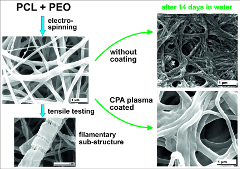
Well-Blended PCL/PEO Electrospun Nanofibers with Functional Properties Enhanced by Plasma Processing
Vojtěch Kupka, Eva Dvořáková, Anton Manakhov, Miroslav Michlíček, Josef Petruš, Lucy Vojtová, Lenka Zajíčková
Polymers 12 (2020) 16
Biodegradable composite nanofibers were electrospun from poly("-caprolactone) (PCL) and poly(ethylene oxide) (PEO) mixtures dissolved in acetic and formic acids. The variation of PCL:PEO concentration in the polymer blend, from 5:95 to 75:25, revealed the tunability of the hydrolytic stability and mechanical properties of the nanofibrous mats. The degradation rate of PCL/PEO nanofibers can be increased compared to pure PCL, and the mechanical properties can be improved compared to pure PEO. Although PCL and PEO have been previously reported as immiscible, the electrospinning into nanofibers having restricted dimensions (250–450 nm) led to a microscopically mixed PCL/PEO blend. However, the hydrolytic stability and tensile tests revealed the segregation of PCL into few-nanometers-thin fibrils in the PEO matrix of each nanofiber. A synergy phenomenon of increased stiffness appeared for the high concentration of PCL in PCL/PEO nanofibrous mats. The pure PCL and PEO mats had a Young’s modulus of about 12 MPa, but the mats made of high concentration PCL in PCL/PEO solution exhibited 2.5-fold higher values. The increase in the PEO content led to faster degradation of mats in water and up to a 20-fold decrease in the nanofibers’ ductility. The surface of the PCL/PEO nanofibers was functionalized by an amine plasma polymer thin film that is known to increase the hydrophilicity and attach proteins efficiently to the surface. The combination of different PCL/PEO blends and amine plasma polymer coating enabled us to tune the surface functionality, the hydrolytic stability, and the mechanical properties of biodegradable nanofibrous mats.

Maleic anhydride and acetylene plasma copolymer surfaces for SPR immunosensing
Ekaterina Makhneva, Zdeněk Farka, Matěj Pastucha, Adam Obrusník, Veronika Horáčková, Petr Skládal, Lenka Zajíčková
Anal. Bioanal. Chem. 411 (2019) 7689-7697
DOI: 10.1007/s00216-019-01979-9
We report on the successful application of carboxyl-rich plasma polymerized (PP) films as a matrix layer for bioreceptor immobilization in surface plasmon resonance (SPR) immunosensing. Composition and chemical properties of the carboxyl-rich PP films deposited from a mixture of maleic anhydride and acetylene were investigated. Changes in the films stored in air, water, and buffer were studied and the involved chemical changes were described. Performance in SPR immunosensing was evaluated on interactions of human serum albumin (HSA) with a specific monoclonal antibody. The comparison with the mixed self-assembled monolayer of mercaptoundecanoic acid and mercaptohexanol (MUA/MCH) and one of the most widely used surfaces for SPR, the 2D and 3D carboxymethylated dextran (CMD), was presented to show the efficacy of plasma polymerized matrix layers for biosensing. The PP film-based SPR immunosensor provided a similar detection limit of HSA (100 ng/mL) as MUA/MCH- (100 ng/mL) and 3D CMD (50 ng/mL)-based sensors. However, the response levels were about twice higher in case of the PP film-based immunosensor than in case of MUA/MCH-based alternative. The PP film surfaces had similar binding capacity towards antibody as the 3D CMD layers. The response of PP film-based sensor towards HSA was comparable to 3D CMD-based sensor up to 2.5 μg/mL. For the higher concentrations (> 10 μg/mL), the response of PP film-based immunosensor was lower due to inaccessibility of active sites of the immobilized antibody inside the flat PP film surface. We have demonstrated that due to its high stability and cost-effective straightforward preparation, the carboxyl-rich PP films represent an efficient alternative to self-assembled monolayers (SAM) and dextran-based layers in label-free immunosensing.
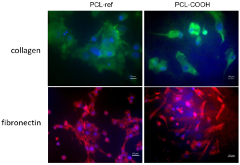
Plasma-Coated Polycaprolactone Nanofibers with Covalently Bonded Platelet-Rich Plasma Enhance Adhesion and Growth of Human Fibroblasts
Svetlana Miroshnichenko, Valeriia Timofeeva, Elizaveta Permykova, Sergey Ershov, Philip Kiryukhantsev-Korneev, Eva Dvořáková, Dmitry V. Shtansky, Lenka Zajíčková, Anastasiya Solovieva, Anton Manakhov
Nanomaterials 9 (2019) 637-655
DOI: 10.3390/nano9040637
Biodegradable nanofibers are extensively employed in different areas of biology and medicine, particularly in tissue engineering. The electrospun polycaprolactone (PCL) nanofibers are attracting growing interest due to their good mechanical properties and a low-cost structure similar to the extracellular matrix. However, the unmodified PCL nanofibers exhibit an inert surface, hindering cell adhesion and negatively affecting their further fate. The employment of PCL nanofibrous scaffolds for wound healing requires a certain modification of the PCL surface. In this work, the morphology of PCL nanofibers is optimized by the careful tuning of electrospinning parameters. It is shown that the modification of the PCL nanofibers with the COOH plasma polymers and the subsequent binding of NH 2 groups of protein molecules is a rather simple and technologically accessible procedure allowing the adhesion, early spreading, and growth of human fibroblasts to be boosted. The behavior of fibroblasts on the modified PCL surface was found to be very different when compared to the previously studied cultivation of mesenchymal stem cells on the PCL nanofibrous meshes. It is demonstrated by X-ray photoelectron spectroscopy (XPS) that the freeze–thawed platelet-rich plasma (PRP) immobilization can be performed via covalent and non-covalent bonding and that it does not affect biological activity. The covalently bound components of PRP considerably reduce the fibroblast apoptosis and increase the cell proliferation in comparison to the unmodified PCL nanofibers or the PCL nanofibers with non-covalent bonding of PRP. The reported research findings reveal the potential of PCL matrices for application in tissue engineering, while the plasma modification with COOH groups and their subsequent covalent binding with proteins expand this potential even further. The use of such matrices with covalently immobilized PRP for wound healing leads to prolonged biological activity of the immobilized molecules and protects these biomolecules from the aggressive media of the wound.
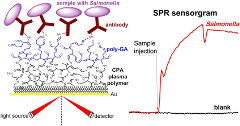
Cyclopropylamine plasma polymer surfaces for label-free SPR and QCM immunosensing of Salmonella
Ekaterina Makhneva, Zdeněk Farka, Petr Skládal, Lenka Zajíčková
Sens. Actuator B-Chem. 276 (2018) 447-455
DOI: 10.1016/j.snb.2018.08.055
We report on the first successful application of nitrogen-containing functional surfaces prepared by plasma polymerization in surface plasmon resonance (SPR) immunosensing. The plasma polymers (PPs) were deposited from cyclopropylamine (CPA) vapors onto gold surfaces of SPR and quartz crystal microbalance (QCM) sensors. It provided an excellent platform for a stable immobilization of antibodies using glutaraldehyde (GA) activation. The performance of the SPR immunosensor was proven by a model pair of monoclonal antibody (Ab) AL-01 and human serum albumin as well as by the selective detection of bacterial pathogen Salmonella Typhimurium using the immobilized anti-Salmonella Ab. A baseline drift of the measured SPR signal, caused by the long-term re- activity of CPA plasma polymers, was well stabilized by 18 h immersion in phosphate buffered saline prior to the GA activation. The immunosensors can be successfully regenerated several times using 10 mM NaOH. The limit of detection of 10 5 CFU/mL and a wide linear response were achieved for Salmonella. The assay parameters are comparable to the conventional label-free methods. However, the replacement of conventional immobilization matrix with the CPA PPs offers an advantage of excellent adhesion to gold QCM and SPR surfaces achieved by fast and eco-friendly procedure compatible with the vacuum deposition of gold.
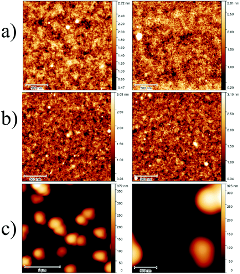
Analysis of epoxy functionalized layers synthesized by plasma polymerization of allyl glycidyl ether
Anton Manakhov, Šárka Fuková, David Nečas, Miroslav Michlíček, Sergey Ershov, Marek Eliáš, Maxim Visotin, Zakhar Popov, Lenka Zajíčková
Physical Chemistry Chemical Physics 20 (2018) 20070-20077
DOI: 10.1039/c8cp01452c
The deposition of epoxide groups by plasma polymerization opens new horizons for robust and quick immobilization of biomolecules on any type of substrate. However, as of now there are just very few papers dealing with the deposition of epoxy layers by plasma polymerization, probably due to the high reactivity of this group leading to a low functionalization efficiency. In this work we carried out an extensive experimental and theoretical investigation of plasma synthesis of epoxide groups from a low pressure allyl glycydyl ether (AGE) plasma. The influence of composite parameter W/F and the working pressure on the density of epoxide groups and the layer stability was thoroughly addressed. It was found that by increasing the working pressure it is possible to sufficiently raise the concentration of epoxide groups. The composite parameter W/F was shown to be a crucial parameter in affecting the density of epoxides. An optimal value of W/F of around 2.3 eV per molecule leading to the highest density of epoxides produced in the process at 15 Pa was revealed through FT-IR and XPS findings. This value correlates well with the ab initio calculations suggesting that the lowest bond dissociation energy belongs to the C–O bond of the epoxide ring. Therefore, in order to increase the density of epoxides deposited by plasma polymerization, a precursor molecule containing at least two epoxide rings is strongly advised to be employed.
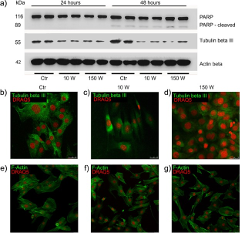
Cyclopropylamine plasma polymers for increased cell adhesion and growth
Anton Manakhov, Marie Landová, Jiřina Medalová, Miroslav Michlíček, Josef Polčák, David Nečas, Lenka Zajíčková
Plasma Processes and Polymers 14 (2017) e1600123
Plasma polymers with NHx groups were deposited from cyclopropylamine in low pressure radio frequency (RF) discharges. The amount of NHx decreased with increasing average power Pav , whereas the layer dissolution in water decreased and high Pav led to a slight film swelling. The C2C12 cells demonstrated very high adhesion to the layers regardless of the deposition conditions. Although the surface chemistry of amine-rich layers should enhance the cell proliferation, the WST-1 assay, and immunocytochemistry revealed lower cell proliferation and viability on the layers exhibiting above 18% of relative thickness loss in water. Promising results were obtained on the layers with better water stability and bearing 7–10% of NHx.